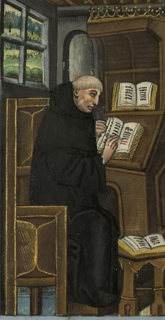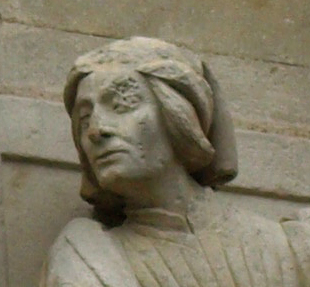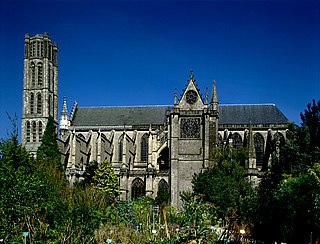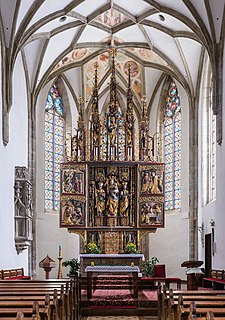
Giles of Rome O.S.A., was a Medieval philosopher and Scholastic theologian and a friar of the Order of St Augustine, who was also appointed to the positions of Prior General of his Order and as Archbishop of Bourges. He is famed as being a logician, producing a commentary on the Organon by Aristotle, and for his authorship of two important works, De Ecclesiastica Potestate, a major text of early 14th century Papalism, and De regimine principum, a guide book for Christian temporal leadership. Giles was styled Doctor Fundatissimus by Pope Benedict XIV.

Varennes-Jarcy is a commune in the Essonne department in northern France, located between Périgny (Val-de-Marne) and Combs-la-Ville (Seine-et-Marne) 25 km from the center of Paris.

Sulpitiusthe Pious was a 7th-century bishop of Bourges and saint.

Jacques Cœur was a French government official and state-sponsored merchant whose personal fortune became legendary and led to his eventual disgrace. He initiated regular trade routes between France and the Levant. His memory retains iconic status in Bourges, where he built a palatial house that is preserved to this day.

Bourges Cathedral is a Roman Catholic church located in Bourges, France. The cathedral is dedicated to Saint Stephen and is the seat of the Archbishop of Bourges. Built atop an earlier Romanesque church from 1195 until 1230, it is largely in the High Gothic architectural style and was constructed at about the same time as Chartres Cathedral. The cathedral is particularly known for the great size and unity of its interior, the sculptural decoration of its portals, and the large collection of 13th century stained glass windows. Owing to its quintessential Gothic architecture, the cathedral was declared a UNESCO World Heritage Site in 1992.

The Roman Catholic Archdiocese of Bourges is an archdiocese of the Latin Rite of the Roman Catholic Church in France. The Archdiocese comprises the departements of Cher and Indre in the Region of Val de Loire. Bourges Cathedral stands in the city of Bourges in the department of Cher. Although this is still titled as an Archdiocese, it ceased as a metropolitan see in 2002 and is now a suffragan in the ecclesiastical province of Tours.

Fulgentius of Ruspe was bishop of the city of Ruspe, Roman province of Africa, North Africa, in modern-day Tunisia, during the 5th and 6th century. He was also canonized as a Christian saint.

The Archdiocese of Bordeaux (–Bazas) is a Latin Church ecclesiastical territory or archdiocese of the Catholic Church in France. The episcopal see is Bordeaux, Aquitaine. It was established under the Concordat of 1802 by combining the ancient Diocese of Bordeaux with the greater part of the suppressed Diocese of Bazas. The Archdiocese of Bordeaux is a metropolitan see, with four suffragan dioceses in its ecclesiastical province: Dioceses of Agen, Aire and Dax, Bayonne, and Périgueux.

The Roman Catholic Diocese of Tulle is a Roman Catholic diocese in Tulle, France. The diocese of Tulle comprises the whole département of Corrèze.

The Roman Catholic Diocese of Limoges is a diocese of the Latin Rite of the Roman Catholic Church in France. The diocese comprises the départments of Haute-Vienne and Creuse. After the Concordat of 1801, the See of Limoges lost twenty-four parishes from the district of Nontron which were annexed to the Diocese of Périgueux, and forty-four from the district of Confolens, transferred to the Diocese of Angoulême; but until 1822 it included the entire ancient Diocese of Tulle, when the latter was reorganized.

The Roman Catholic Diocese of Orléans is a diocese of the Latin Rite of the Roman Catholic Church in France. The diocese currently corresponds to the Départment of Loiret. The current bishop is Jacques André Blaquart, who was appointed in 2010.

Le Mans Cathedral is a Catholic church situated in Le Mans, France. The cathedral is dedicated to Saint Julian of Le Mans, the city's first bishop, who established Christianity in the area around the beginning of the 4th century. Its construction dated from the 6th through the 14th century, and it features many French Gothic elements.

The Roman Catholic Diocese of Saint-Flour is a diocese of the Latin Rite of the Roman Catholic Church in France. The diocese comprises the department of Cantal. Erected in 1317, the diocese was suffragan of the Archdiocese of Bourges until 2002. With the general reorganization of the structure of the French church by Pope John Paul II, Saint-Flour became the suffragan of the Archdiocese of Clermont. The seat of the bishop is located in Saint-Flour, Cantal.

Rodulf was the archbishop of Bourges from 840 until his death. He is remembered as a skillful diplomat and a proponent of ecclesiastical reform. As a saint, his feast has been celebrated on 21 June.

The Roman Catholic Diocese of Mende is a diocese of the Latin Rite of the Roman Catholic Church in France. The diocese covers the department of Lozère.

The Roman Catholic Archdiocese of Clermont is an archdiocese of the Latin Rite of the Roman Catholic Church in France. The diocese comprises the department of Puy-de-Dôme, in the Region of Auvergne. The Archbishop's seat is Clermont-Ferrand Cathedral. Throughout its history Clermont was the senior suffragan of the Archdiocese of Bourges. It became a metropolitan see itself, however, in 2002. The current archbishop is François Kalist.

Guillaume de Donjeon was a French Roman Catholic prelate who served as the Archbishop of Bourges from 1200 until his death. He served as a canon in Soissons and Paris before he entered the Order of Grandmont. Sometime later he entered the Cistercians. He was known to practice austerities such as abstaining from meat and wearing a hair shirt.

In the Catholic Church, the altar is the structure upon which the Sacrifice of the Mass is offered.

High Gothic is a particularly refined and imposing style of Gothic architecture that appeared in northern France from about 1195 until 1250. Notable examples include Chartres Cathedral, Reims Cathedral, Amiens Cathedral, Beauvais Cathedral, and Bourges Cathedral. It is characterized by great height, harmony, subtle and refined tracery and realistic sculpture, and by large stained glass windows, particularly rose windows and larger windows on the upper levels, which filled the interiors with light. It followed Early Gothic architecture and was succeeded by the Rayonnant style. It is often described as the high point of the Gothic style.
Bourges is a city in central France which is capital of the department of Cher.


















